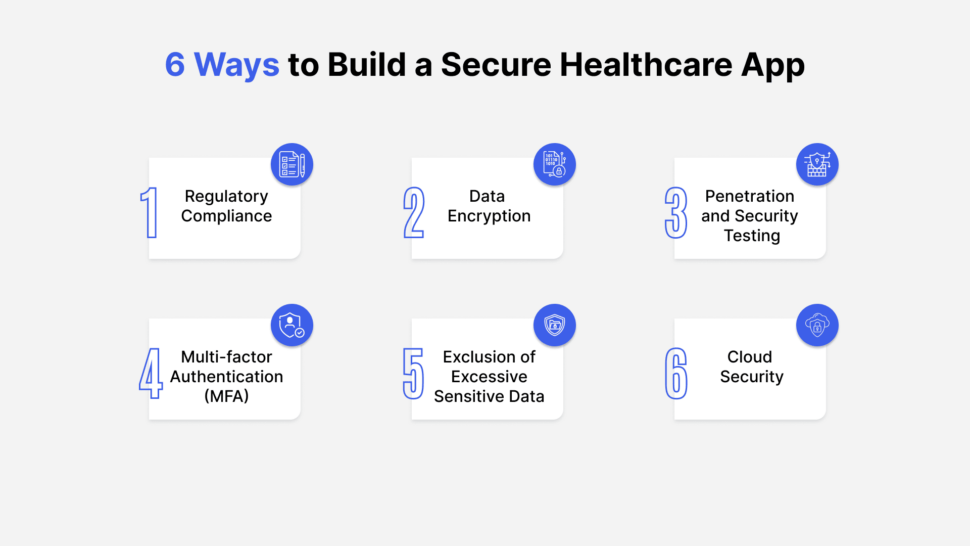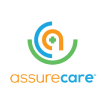Solutions like data encryption, penetration and security testing, backend security, and biometric/multi-factor authentication can help you plan a security-driven healthcare mobile app development process. These solutions can protect a healthcare app from various security threats. You may know these threats as viruses, ransomware, trojans, denial of service (DoS) attacks, man-in-the-middle attacks (MITM), data theft/leaks, API injection attack, code tampering, and identity theft.
Healthcare mobile apps can always be vulnerable to such attacks due to the confidential/sensitive nature of their content. The increasing demand and number of healthcare apps also increase security risks. For example, the Google Play store had over 54,546 healthcare apps in the third quarter of 2022.
Such rapidly rising numbers can affect the quality standards of healthcare apps, leading to vulnerabilities like weak encryption, poor authentication, weak server-side security, insecure database, and excessive data exposure.
Therefore, you must consider the practical applications and benefits of healthcare app security mentioned in this piece. It helps protect patients and healthcare institutions from many data security, privacy, and financial/legal issues.
6 Ways to Build a Secure Healthcare App
The easiest way to create a secure healthcare/telemedicine app is by following the mobile app security standards of Apple and Android.

Regulatory Compliance
Regulatory compliance in healthcare mobile app development is about the dedication of healthcare institutions towards complying with various regulations, laws, and guidelines for medical practices carried out and provided through a digital platform. Every region/country has such laws, regulations, and security guidelines. They protect patients and healthcare institutions from many data security and privacy issues.
Some example:
The Health Information Technology for Economic and Clinical Health (HITECH) Act
The HITECH Act aims to improve operational efficiency, safety, and quality of healthcare solutions offered through your app. It majorly focuses on encouraging the adoption of electronic healthcare records. EHRs can improve data security and accessibility through encryption and strong user authentication.
HIPAA Compliance
The Health Insurance Portability and Accountability Act (HIPAA) compliance is a set of regulations that every healthcare institution must comply with and follow in order to protect sensitive healthcare information like medical records.
GDPR
General Data Protection Regulation (GDPR) is another set of regulations and guidelines that help organizations secure the collection, storage, and disclosure of personal information. In a healthcare app, it helps regulate the process of patient data collection and management.
The Payment Card Industry-Data Security Standard (PCI DSS)
User-friendly online payments are necessary for healthcare app services like Booking an Appointment or Ordering Medicine. It is when the PCI DSS standard comes into play. It is a compliance that requires all organizations that process and store credit card information to maintain security. It enforces security protocols like firewall usage and maintenance, anti-virus, and regular pen/security testing.
Complying with such healthcare compliance regulations may not always be legally mandatory in all regions. But they are designed to protect your app from the most common security threats, data theft, and leakage.
Data Encryption
Encrypting the sensitive data in your healthcare/telemedicine app converts it into a format that one can only access, use, and read with an encryption key created/provided during data encryption. Apps in the healthcare and fintech sector always contain some or more confidential/sensitive data, which can cause many legal, financial, and personal issues if it is stolen or leaked.
Data encryption can prevent this by making the data unreadable and useless to those who do not have the encryption key. It helps prevent unauthorized access to organizational and user data in your app. Encryption helps build secure healthcare apps that can protect the data security and privacy of patients and medical institutions.
Penetration and Security Testing
Security testing helps identify vulnerabilities in your healthcare app that could lead to cyber-attacks and data breaches. Penetration is similar but more advanced and helpful as it helps identify security vulnerabilities, the current and potential risks they pose, and how to deal with and prevent them.
These app testing solutions must be mandatory in your medical app and you must hire a healthcare app development company that can incorporate such solutions effectively. They help evaluate data security, third-party API risks, authentication, server, data transfer features, and password functionality of the app.
While security testing helps identify vulnerabilities from the perspective of security experts, penetration testing helps identify them from the perspective of hackers/attackers, which can help you secure your telemedicine app from every angle.
Therefore, your healthcare app development process must include solutions like manual and automated pen testing, mobile application security testing (MAST), static application security testing (SAST), dynamic application security testing (DAST), software composition analysis (SCA), database security assessment, and interactive application security testing (IAST).
These security protocols will help you secure your healthcare app before deployment, creating a safe digital environment for patients and medical institutions.
Multi-factor Authentication (MFA)
Multi-factor authentication (MFA) helps incorporate multiple authentication protocols like OTP verification, password, pin code, and biometric authentication for user authentication. It prevents hackers from accessing the account of patients, doctors, and admins by preventing unauthorized access.
Include facial and voice recognition, retina scanning, and fingerprint scanning in the biometric authentication of your healthcare app. You may also incorporate medical education number (ME number) verification for authenticating physicians on your healthcare app. This type of ME number authentication will help you improve doctor account and data security, which can contain a lot of sensitive/confidential information.
Another effective authentication protocol is the OTP request verification during every user login. Users (patients and doctors) will get a code through SMS, email, or Google authenticator when they use their credentials to access the accounts. Only after submitting that code can users access their accounts. While this may seem excessive, it can better protect user identity, data security, and privacy of all customers.
Exclusion of Excessive Sensitive Data
Poor data management can often create most of the data security vulnerabilities in a telemedicine application. More importantly, including too much sensitive/confidential information in the app database increases the data breach risks. You must frequently evaluate the necessity of all sensitive data in your app and remove the information not required for the regular operation of the app. How does this help?
Data theft and leakage are common issues in mobile apps and websites, and a skilled hacker can find a way to access any data even if one uses top-of-the-line security solutions. That is why reducing the amount of sensitive data in the healthcare app can help you minimize the damage/risks when such attacks occur. While it is not a solution, this precautionary measure can sometimes help prevent many legal and financial issues in the healthcare app.
Cloud Security
Using cloud computing in healthcare applications is one of the best ways to secure application data. Determine the cloud solutions for your app during healthcare app development. Using cloud computing in healthcare solutions is one of the most common healthcare technology trends recommended by many security experts. Some benefits are data backups, regulatory health compliance, security threat monitoring and detection, 24/7 accessibility and monitoring, better scalability, improved data encryption, and DDoS attack prevention.
Conclusion
Ensuring reliable security in healthcare apps requires compliance with security standards, frequent penetration/security testing during and after development, and regular application updates. Outdated security protocols are the common causes of most security vulnerabilities, leading to data breach issues for patients and healthcare institutions. Therefore, you must keep up to date with and incorporate the latest developments in app security during the healthcare mobile app development process.
In short, meet security standards and regularly evaluate and update the security solutions of your healthcare app. And you can create a safe digital platform for all healthcare operations.
Frequently Asked Questions
Data encryption, regulatory compliance, multi-factor/biometric authentication, and pen/security testing are the best protocols for securing applications.
App security protocols like data encryption, firewalls, anti-virus, and pen/security testing can safeguard an app from various security vulnerabilities and threats. For example, data encryption makes it impossible for unauthorized users to access data without the encryption key. While pen/security testing helps identify vulnerabilities that can lead to security threats like malware attacks, data leakage, and man-in-the-middle (MiTM) attacks.
As mentioned above, a secure phone app that meets all security standards frequently evaluates its security through pen/security testing, has a secure database, and includes advanced authentication solutions.
Yes, the Health Information Portability and Accountability Act (HIPAA) helps improve the operational efficiency and security of all health apps.
The healthcare app development cost can range from $7,500 to $150,000 and $300,000, depending on the healthcare app category (fitness, hospital app, mental wellness), platforms, app complexity, UI/UX design, number and type of features, and app developers. Only after evaluating and determining these factors can you estimate the development cost for your healthcare app.
Whether they need approval from the FDA (or not) entirely depends on the regions your medical app serves. However, the FDA is responsible for ensuring the safety and effectiveness of medical applications.



















.png)
.png)
.png)



Leave a Comment